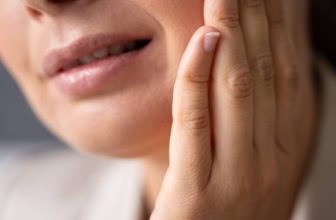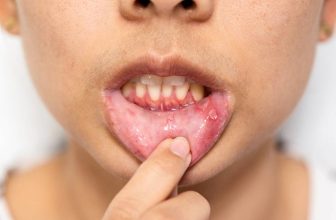Gum recession can be a scary thing. It’s the process of the gum tissue around your teeth wearing away, exposing more of the tooth or the tooth’s root. When this happens, pockets form between the teeth and gum line, making it easy for bacteria to build up. If left untreated, your teeth’ supporting tissues and bone structures can be severely damaged.
The good news is that gum recession is not something you have to live with. There are treatments available that can repair the gum and prevent further damage. So if you think your gums are receding, make an appointment with your dentist today.
Leading Causes of Receding Gums
Most people don’t realize that receding gums is a common dental problem. It’s estimated that over half of American adults have some form of gum recession. While many things can cause gum recession, there are three primary causes: brushing too hard, periodontal disease, and genetics.
1. Brushing Too Hard

One of the most common causes of gum recession is brushing your teeth too aggressively. This can damage the delicate gum tissue and cause it to pull away from the tooth root. If you brush too hard regularly, you’ll likely experience gum recession at some point in your life.
2. Periodontal Disease
Another common cause of gum recession is periodontal disease. This is a severe infection of the gums that can damage the gum tissue and lead to tooth loss. Periodontal disease is caused by a build-up of plaque and tartar on the teeth. If not treated, it can destroy the gums and bones that support the teeth.
3. Genetics
Sometimes, receding gums can be due to genetics. If your parents or grandparents had gum recession, you might be more likely to experience it yourself. Gum recession is also more common as we age, so if you’re getting older, you may be more susceptible to it.
4. Poor Dental Care
Neglecting your oral hygiene can also lead to receding gums. If you don’t brush and floss regularly, plaque and tartar will build up on your teeth. This can cause the gum tissue to become inflamed and eventually recede.
5. Tobacco Products
Smoking is another major factor that can contribute to gum recession. Tobacco use can damage the gum tissue and make it more susceptible to infection. It’s also one of the leading causes of periodontal disease. If you smoke, you’re much more likely to experience gum recession than someone who doesn’t.
6. Misaligned Bite
If your teeth are misaligned, it can stress the gum tissue unnecessarily. This can cause the gums to recede over time. If you have an uneven bite, talk to your dentist about ways to correct it.
7. Teeth Grinding

Teeth grinding (bruxism) is another common factor leading to gum recession. Grinding your teeth puts a lot of pressure on the gums and can damage the tissue. If you grind your teeth at night, you may be more likely to experience gum recession.
8. Dental Procedures
Specific dental procedures can also cause gum recession. For example, if you have your teeth professionally cleaned (scaled), it can damage the gum tissue. Likewise, having braces or other dental appliances can also lead to gum recession.
9. Tongue or facial piercings
Tongue or facial piercings can also damage the gum tissue and cause it to recede. The jewelry can rub against the gums and irritate the tissue. If you have a tongue piercing, it’s especially important to clean it regularly to prevent infection.
10. Hormonal Changes
Hormonal changes in the body can also lead to gum recession.
For example, pregnancy can cause an increase in hormones that can make the gums more sensitive. This can make them more likely to recede during pregnancy.
While gum recession is a common problem, there are ways to prevent it.
How to Stop Receding Gums from Getting Worse And How To Prevent Them In Future
Your gums are receding. You know it, and your dentist has probably told you it’s happening. But what can you do about it? Unfortunately, there is no one-size-fits-all answer to this question. The good news, however, is that you can do several things to try to stop your gums from receding any further – and even reverse the process.
1. Good oral hygiene
One of the most important things you can do is ensure you take good care of your teeth and gums. This means brushing and flossing regularly and seeing your dentist for regular checkups. It’s also important to avoid habits that can damage your gums, such as smoking or chewing tobacco.
2. Improving diet

There are also a number of lifestyle changes you can make to help keep your gums healthy. Eating a healthy diet, for example, is important. Ensure you eat plenty of fruits and vegetables and choose lean protein sources instead of processed foods. It’s also important to drink plenty of water each day.
3. Quit smoking
If you smoke, one of the best things you can do for your gums is to quit. Smoking is a significant risk factor for gum disease and can make it harder for your gums to heal after an injury. If you’re having trouble quitting, talk to your doctor about ways to make it easier.
4. Visit the Dentist Regularly

Another critical step is to visit your dentist regularly. Your dentist can help you spot early signs of gum disease and take steps to prevent it from getting worse. They can also recommend treatments to help stop your gums from receding further.
Treatments for Receding Gums

1. Dental cleanings
Regular professional dental cleanings are the most effective ways to treat receding gums. During a cleaning, your dentist or hygienist will remove plaque and tartar from your teeth, which can help reduce inflammation and gum disease.
2. Scaling and root planing
If you have periodontitis, your dentist may recommend a deeper cleaning called scaling and root planing. This procedure involves removing plaque and tartar from below the gum line and smoothing out any rough spots on the tooth roots to prevent bacteria from accumulating there.
3. Bone Regeneration
In some cases, bone regeneration may be necessary to help stop the progression of periodontitis. This procedure involves using bone grafts or tissue regenerators to encourage new bone growth in the jaw.
4. Soft Tissue Grafts
If your gums have receded significantly, your dentist may recommend a soft tissue graft. This procedure involves taking tissue from another area of your mouth (or sometimes from a donor) and using it to cover the exposed root surfaces.
5. Crown Lengthening
In some cases, receding gums can make your teeth look too long. If this is the case, your dentist may recommend crown lengthening. This involves removing gum tissue around the tooth to make it appear shorter.
6. LANAP treatment
If you are already experiencing some degree of gum recession, there are a number of treatments your dentist may recommend. One option is a dental laser treatment called LANAP. This treatment uses a laser to remove the bacteria that cause gum disease, which can help stop the receding process. If you need surgery to correct gum recession, your dentist may recommend using a donor tissue or an implant to rebuild the lost bone structure.
No matter what course of action you decide to take, it is essential to remember that reversing the gum recession takes time and patience. But by following these tips and working closely with your dentist, you can hopefully halt the progress of this condition and keep your smile looking healthy and beautiful for years to come.







